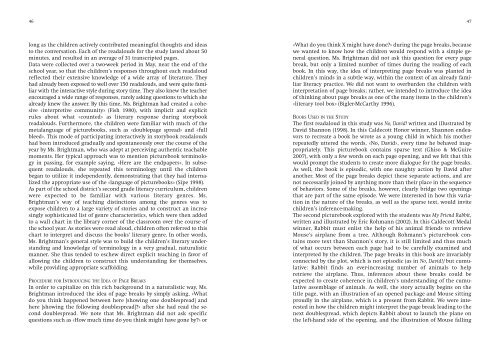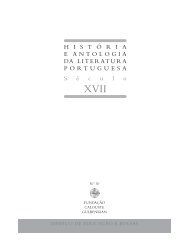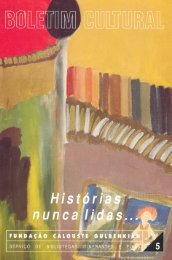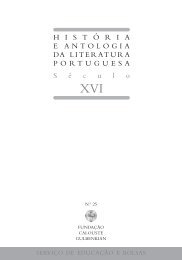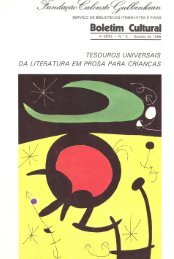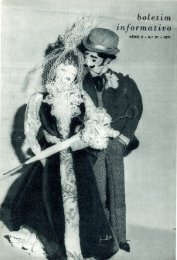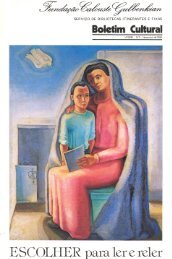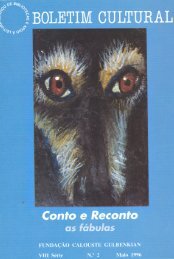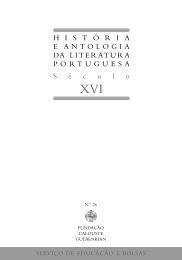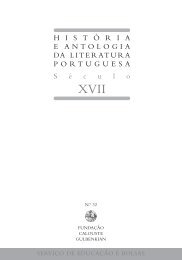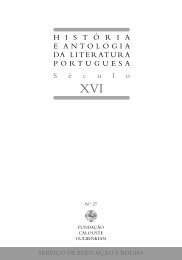Formar Leitores para Ler o Mundo - Leitura Gulbenkian - Fundação ...
Formar Leitores para Ler o Mundo - Leitura Gulbenkian - Fundação ...
Formar Leitores para Ler o Mundo - Leitura Gulbenkian - Fundação ...
You also want an ePaper? Increase the reach of your titles
YUMPU automatically turns print PDFs into web optimized ePapers that Google loves.
46<br />
long as the children actively contributed meaningful thoughts and ideas<br />
to the conversation. Each of the readalouds for the study lasted about 50<br />
minutes, and resulted in an average of 31 transcripted pages.<br />
Data were collected over a two-week period in May, near the end of the<br />
school year, so that the children’s responses throughout each readaloud<br />
reflected their extensive knowledge of a wide array of literature. They<br />
had already been exposed to well over 150 readalouds, and were quite familiar<br />
with the interactive style during story time. They also knew the teacher<br />
encouraged a wide range of responses, rarely asking questions to which she<br />
already knew the answer. By this time, Ms. Brightman had created a cohesive<br />
«interpretive community» (Fish 1980), with implicit and explicit<br />
rules about what «counted» as literary response during storybook<br />
readalouds. Furthermore, the children were familiar with much of the<br />
metalanguage of picturebooks, such as «doublepage spread» and «full<br />
bleed». This mode of participating interactively in storybook readalouds<br />
had been introduced gradually and spontaneously over the course of the<br />
year by Ms. Brightman, who was adept at perceiving authentic teachable<br />
moments. Her typical approach was to mention picturebook terminology<br />
in passing, for example saying, «Here are the endpapers». In subsequent<br />
readalouds, she repeated this terminology until the children<br />
began to utilize it independently, demonstrating that they had internalized<br />
the appropriate use of the «language of picturebooks» (Sipe 1998).<br />
As part of the school district’s second grade literacy curriculum, children<br />
were expected to be familiar with various literary genres. Ms.<br />
Brightman’s way of teaching distinctions among the genres was to<br />
expose children to a large variety of stories and to construct an increasingly<br />
sophisticated list of genre characteristics, which were then added<br />
to a wall chart in the library corner of the classroom over the course of<br />
the school year. As stories were read aloud, children often referred to this<br />
chart to interpret and discuss the books’ literary genre. In other words,<br />
Ms. Brightman’s general style was to build the children’s literary understanding<br />
and knowledge of terminology in a very gradual, naturalistic<br />
manner. She thus tended to eschew direct explicit teaching in favor of<br />
allowing the children to construct this understanding for themselves,<br />
while providing appropriate scaffolding.<br />
PROCEDURE FOR INTRODUCING THE IDEA OF PAGE BREAKS<br />
In order to capitalize on this rich background in a naturalistic way, Ms.<br />
Brightman introduced the idea of page breaks by simply asking, «What<br />
do you think happened between here [showing one doublespread] and<br />
here [showing the following doublespread]?» after she had read the second<br />
doublespread. We note that Ms. Brightman did not ask specific<br />
questions such as «How much time do you think might have gone by?» or<br />
«What do you think X might have done?» during the page breaks, because<br />
we wanted to know how the children would respond with a simple general<br />
question. Ms. Brightman did not ask this question for every page<br />
break, but only a limited number of times during the reading of each<br />
book. In this way, the idea of interpreting page breaks was planted in<br />
children’s minds in a subtle way, within the context of an already familiar<br />
literacy practice. We did not want to overburden the children with<br />
interpretation of page breaks; rather, we intended to introduce the idea<br />
of thinking about page breaks as one of the many items in the children’s<br />
«literary tool box» (Bigler-McCarthy 1996).<br />
BOOKS USED IN THE STUDY<br />
The first readaloud in this study was No, David! written and illustrated by<br />
David Shannon (1998). In this Caldecott Honor winner, Shannon endeavors<br />
to recreate a book he wrote as a young child in which his mother<br />
repeatedly uttered the words, «No, David», every time he behaved inappropriately.<br />
This picturebook contains sparse text (Ghiso & McGuire<br />
2007), with only a few words on each page opening, and we felt that this<br />
would prompt the students to create more dialogue for the page breaks.<br />
As well, the book is episodic, with one naughty action by David after<br />
another. Most of the page breaks depict these se<strong>para</strong>te actions, and are<br />
not necessarily joined by anything more than their place in the sequence<br />
of behaviors. Some of the breaks, however, clearly bridge two openings<br />
that are part of the same episode. We were interested in how this variation<br />
in the nature of the breaks, as well as the sparse text, would invite<br />
children’s inference-making.<br />
The second picturebook explored with the students was My Friend Rabbit,<br />
written and illustrated by Eric Rohmann (2002). In this Caldecott Medal<br />
winner, Rabbit must enlist the help of his animal friends to retrieve<br />
Mouse’s airplane from a tree. Although Rohmann’s picturebook contains<br />
more text than Shannon’s story, it is still limited and thus much<br />
of what occurs between each page had to be carefully examined and<br />
interpreted by the children. The page breaks in this book are invariably<br />
connected by the plot, which is not episodic (as in No, David!) but cumulative:<br />
Rabbit finds an ever-increasing number of animals to help<br />
retrieve the airplane. Thus, inferences about these breaks could be<br />
expected to create coherence in children’s understanding of the cumulative<br />
assemblage of animals. As well, the story actually begins on the<br />
title page, with an illustration of an opened package and Mouse sitting<br />
proudly in the airplane, which is a present from Rabbit. We were interested<br />
in how the children might interpret the page break leading to the<br />
next doublespread, which depicts Rabbit about to launch the plane on<br />
the left-hand side of the opening, and the illustration of Mouse falling<br />
47


